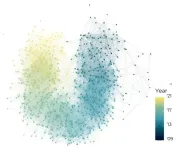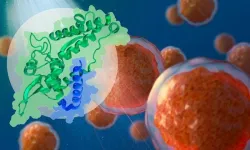(Press-News.org) CAMBRIDGE, MA -- Patients undergoing chemotherapy often experience cognitive effects such as memory impairment and difficulty concentrating — a condition commonly known as “chemo brain.”
MIT researchers have now shown that a noninvasive treatment that stimulates gamma frequency brain waves may hold promise for treating chemo brain. In a study of mice, they found that daily exposure to light and sound with a frequency of 40 hertz protected brain cells from chemotherapy-induced damage. The treatment also helped to prevent memory loss and impairment of other cognitive functions.
This treatment, which was originally developed as a way to treat Alzheimer’s disease, appears to have widespread effects that could help with a variety of neurological disorders, the researchers say.
“The treatment can reduce DNA damage, reduce inflammation, and increase the number of oligodendrocytes, which are the cells that produce myelin surrounding the axons,” says Li-Huei Tsai, director of MIT’s Picower Institute for Learning and Memory and the Picower Professor in the MIT Department of Brain and Cognitive Sciences. “We also found that this treatment improved learning and memory, and enhanced executive function in the animals.”
Tsai is the senior author of the new study, which appears today in Science Translational Medicine. The paper’s lead author is TaeHyun Kim, an MIT postdoc.
Protective brain waves
Several years ago, Tsai and her colleagues began exploring the use of light flickering at 40 hertz (cycles per second) as a way to improve the cognitive symptoms of Alzheimer’s disease. Previous work had suggested that Alzheimer’s patients have impaired gamma oscillations — brain waves that range from 25 to 80 hertz (cycles per second) and are believed to contribute to brain functions such as attention, perception, and memory.
Tsai’s studies in mice have found that exposure to light flickering at 40 hertz or sounds with a pitch of 40 hertz can stimulate gamma waves in the brain, which has many protective effects, including preventing the formation of amyloid beta plaques. Using light and sound together provides even more significant protection. The treatment also appears promising in humans: Phase 1 clinical trials in people with early-stage Alzheimer’s disease have found the treatment is safe and does offer some neurological and behavioral benefits.
In the new study, the researchers set out to see whether this treatment could also counteract the cognitive effects of chemotherapy treatment. Research has shown that these drugs can induce inflammation in the brain, as well as other detrimental effects such as loss of white matter — the networks of nerve fibers that help different parts of the brain communicate with each other. Chemotherapy drugs also promote loss of myelin, the protective fatty coating that allows neurons to propagate electrical signals. Many of these effects are also seen in the brains of people with Alzheimer’s.
“Chemo brain caught our attention because it is extremely common, and there is quite a lot of research on what the brain is like following chemotherapy treatment,” Tsai says. “From our previous work, we know that this gamma sensory stimulation has anti-inflammatory effects, so we decided to use the chemo brain model to test whether sensory gamma stimulation can be beneficial.”
As an experimental model, the researchers used mice that were given cisplatin, a chemotherapy drug often used to treat testicular, ovarian, and other cancers. The mice were given cisplatin for five days, then taken off of it for five days, then on again for five days. One group received chemotherapy only, while another group was also given 40-hertz light and sound therapy every day.
After three weeks, mice that received cisplatin but not gamma therapy showed many of the expected effects of chemotherapy: brain volume shrinkage, DNA damage, demyelination, and inflammation. These mice also had reduced populations of oligodendrocytes, the brain cells responsible for producing myelin.
However, mice that received gamma therapy along with cisplatin treatment showed significant reductions in all of those symptoms. The gamma therapy also had beneficial effects on behavior: Mice that received the therapy performed much better on tests designed to measure memory and executive function.
“A fundamental mechanism”
Using single-cell RNA sequencing, the researchers analyzed the gene expression changes that occurred in mice that received the gamma treatment. They found that in those mice, inflammation-linked genes and genes that trigger cell death were suppressed, especially in oligodendrocytes, the cells responsible for producing myelin.
In mice that received gamma treatment along with cisplatin, some of the beneficial effects could still be seen up to four months later. However, the gamma treatment was much less effective if it was started three months after the chemotherapy ended.
The researchers also showed that the gamma treatment improved the signs of chemo brain in mice that received a different chemotherapy drug, methotrexate, which is used to treat breast, lung, and other types of cancer.
“I think this is a very fundamental mechanism to improve myelination and to promote the integrity of oligodendrocytes. It seems that it’s not specific to the agent that induces demyelination, be it chemotherapy or another source of demyelination,” Tsai says.
Because of its widespread effects, Tsai’s lab is also testing gamma treatment in mouse models of other neurological diseases, including Parkinson’s disease and multiple sclerosis. Cognito Therapeutics, a company founded by Tsai and MIT Professor Edward Boyden, has finished a phase 2 trial of gamma therapy in Alzheimer’s patients, and plans to begin a phase 3 trial this year.
“My lab’s major focus now, in terms of clinical application, is Alzheimer’s; but hopefully we can test this approach for a few other indications, too,” Tsai says.
###
The research was funded by the JPB Foundation, the Ko Hahn Seed Fund, and the National Institutes of Health.
END
A noninvasive treatment for “chemo brain”
Stimulating gamma brain waves may protect cancer patients from memory impairment and other cognitive effects of chemotherapy.
2024-03-06
ELSE PRESS RELEASES FROM THIS DATE:
Film festivals are becoming more diverse in several ways, new study reports
2024-03-06
A group of Tallinn University researchers has published an innovative study that sheds light on the intricate dynamics of the global film festival circuit, revealing insights into diversity and public value creation within the industry. The research demonstrates that festival programming has become more thematically diverse, and the inclusion of films by women creatives has increased between 2012–2021.
The study “Quantifying the global film festival circuit: Networks, diversity, and public value creation,” published open access in the PLOS ONE journal, provides a comprehensive analysis of over 600 film festivals worldwide, spanning a period ...
New hydrogen producing method is simpler and safer
2024-03-06
Researchers in Sweden unveiled a new concept for producing hydrogen energy more efficiently, splitting water into oxygen and hydrogen without the dangerous risk of mixing the two gases.
Developed at KTH Royal Institute of Technology in Stockholm, the new method decouples the standard electrolysis process for producing hydrogen gas, which splits water molecules by applying an electric current. In contrast with prevailing systems it produces the resulting oxygen and hydrogen gases separately rather than simultaneously in the same cell, where they need to be separated by membrane barriers
That separation eliminates the possibility of the gases mixing with the risk of explosions, says ...
Studying the relationship between cancer-promoting proteins
2024-03-06
By Simonne Griffith-Jones, Predoctoral Fellow, EMBL Grenoble
Researchers from the Bhogaraju Group at EMBL Grenoble have gained new insights into how a cancer-relevant family of proteins bind their targets. The results of the study, published in The EMBO Journal, could potentially help in the development of drugs against certain chemotherapy- and radiotherapy-resistant cancers.
The Melanoma Antigen Gene (MAGE) family consists of more than 40 proteins in humans, most of which are only present in the ...
UTA educating schoolchildren about solar eclipse
2024-03-06
The University of Texas at Arlington has received a grant from the National Science Foundation (NSF) to support educational activities related to the upcoming eclipse.
UTA faculty and graduate students are visiting elementary, middle and high schools in the DFW area in March to give talks to about 4,000 students explaining the natural phenomena occurring during the eclipse and the physics behind it. UTA will also provide special eclipse glasses for students to use to avoid eye damage.
The $50,000 grant will also provide for about 1,500 students to take field trips to the UTA Planetarium, one of the three largest in Texas, to learn ...
Espresso yourself: Wearable tech measures emotional responses to coffee
2024-03-06
Researchers in Italy have introduced a novel approach for assessing the quality of coffee. In a pioneering new study, they have demonstrated the feasibility of using wearable technology to measure the emotional responses of coffee experts during tastings.
Published in SCI’s Journal of the Science of Food and Agriculture, the study provides an innovative solution for reducing judgement biases that can result from traditional and more subjective methods of coffee quality assessment.
Coffee is one of the most popular and widely consumed beverages in the world, ...
What drives ‘drug-induced homicide’ prosecutions in North Carolina?
2024-03-06
A new study finds that prosecutors in North Carolina believe “drug-induced homicide” (DIH) laws are effective at both reducing drug overdoses in a community and curtailing the distribution of illicit drugs. These beliefs are worth noting because there is no evidence to support them, while there is evidence that DIH prosecutions make people in affected communities less likely to call 911 – and may actually increase the number of overdoses in a community.
DIH laws, also called “death by distribution” or “delivery resulting in death” laws, ...
Psychosocial stressors linked to higher inflammation in Black pregnant women
2024-03-06
UNIVERSITY PARK, Pa. — Living in neighborhoods with more white residents and greater lifetime experiences of racial discrimination are linked to increased systemic inflammation during pregnancy among Black women, according to new research led by a team from Penn State. The study, published in the February issue of the journal Brain, Behavior, & Immunity – Health, found that these social-environmental factors were associated with higher levels of a protein that has been connected to chronic stress and an elevated risk of ...
Amyloid blood levels associated with brain changes in Alzheimer's study
2024-03-06
New research published today suggests there is a link between abnormal blood levels of amyloid — a protein associated with Alzheimer’s disease — and subtle changes in brain microstructures on a type of MRI, findings that could lead to a new way to detect Alzheimer’s earlier in people with no clinical signs.
Researchers analyzed the results of 128 human participants with and without dementia from the 1Florida Alzheimer’s Disease Research Center who underwent imaging scans using an established diagnostic tool called positron emission tomography, or PET, which can detect amyloid plaques in the brain, a hallmark ...
Linkage case management and posthospitalization outcomes in people with HIV
2024-03-06
About The Study: In this randomized clinical trial that involved 500 hospitalized people with HIV, a linkage case management intervention did not reduce 12-month mortality outcomes. These findings may help inform decisions about the potential role of linkage case management among hospitalized people with HIV.
Authors: Robert N. Peck, M.D., Ph.D., of Weill Cornell Medicine in New York, is the corresponding author.
To access the embargoed study: Visit our For The Media website at this link https://media.jamanetwork.com/
(doi:10.1001/jama.2024.2177)
Editor’s ...
Study quantifies dramatic rise in school shootings and related fatalities since 1970
2024-03-06
Key Takeaways
Incidence of school shootings increasing dramatically: In the 53 years leading up to May 2022, the number of school shootings annually increased more than 12 times.
Children more likely to be victims. The likelihood of children being school shooting victims has increased more than fourfold, and the rate of death from school shootings has risen more than sixfold.
A total of 2,056 school shooting incidents were analyzed: The incidents involved 3,083 victims, including 2,033 children ages 5-17 years, and 1,050 adults ages 18-74 years.
CHICAGO: The ...
LAST 30 PRESS RELEASES:
Scalable and healable gradient textiles for multi‑scenario radiative cooling via bicomponent blow spinning
Research shows informed traders never let a good climate crisis go to waste
Intelligent XGBoost framework enhances asphalt pavement skid resistance assessment
Dual-function biomaterials for postoperative osteosarcoma: Tumor suppression and bone regeneration
New framework reveals where transport emissions concentrate in Singapore
NTP-enhanced lattice oxygen activation in Ce-Co catalysts for low-temperature soot combustion
Synergistic interface engineering in Cu-Zn-Ce catalysts for efficient CO2 hydrogenation to methanol
COVID-19 leaves a lasting mark on the human brain
Scientists use ultrasound to soften and treat cancer tumors without damaging healthy tissue
Community swimming program for Black youth boosts skills, sense of belonging, study finds
Specific depressive symptoms in midlife linked to increased dementia risk
An ‘illuminating’ design sheds light on cholesterol
Who is more likely to get long COVID?
Study showcases resilience and rapid growth of “living rocks”
Naval Research Lab diver earns Office of Naval Research 2025 Sailor of the Year
New Mayo-led study establishes practical definition for rapidly progressive dementia
Fossil fuel industry’s “climate false solutions” reinforce its power and aggravate environmental injustice
Researchers reveal bias in a widely used measure of algorithm performance
Alcohol causes cancer. A study from IOCB Prague confirms damage to DNA and shows how cells defend against it
Hidden viruses in wastewater treatment may shape public health risks, study finds
Unlock the power of nature: how biomass can transform climate mitigation
Biochar reshapes hidden soil microbes that capture carbon dioxide in farmland
Reducing saturated fat intake shows mortality benefit, but only in high-risk individuals
Manta rays create mobile ecosystems, study finds
Study: Mixed results in using lipoic acid to treat progressive multiple sclerosis
Norbert Holtkamp appointed director of Fermi National Accelerator Laboratory
New agentic AI platform accelerates advanced optics design
Biologists discover neurons use physical signals — not electricity — to stabilize communication
Researchers discover that a hormone can access the brain by hitchhiking
University of Oklahoma researcher awarded funding to pursue AI-powered material design
[Press-News.org] A noninvasive treatment for “chemo brain”Stimulating gamma brain waves may protect cancer patients from memory impairment and other cognitive effects of chemotherapy.




